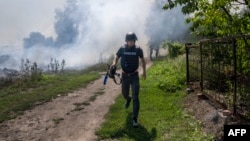As a reporter in the early 1990s, Bruce Shapiro had a “steady diet of difficult stories.” Criminal justice, police violence, interviews with Holocaust survivors and combat veterans.
He knew trauma and tragedy well and considered himself a sensitive reporter.
But when he became a victim of a violent crime, Shapiro says, “I realized that actually I didn’t understand anything.”
Shapiro was badly wounded in a mass stabbing in 1994. The incident attracted widespread media coverage, and Shapiro soon found himself fielding questions from reporters and watching footage of the aftermath of the attack on the nightly news.
Until then, he said, he hadn’t fully considered the effect of news coverage on those affected, or how reporting on tragedies might affect the journalists doing the reporting.
But that recognition, he told VOA, “had immediately very big implications for the craft of reporting, for our ethics, for whose stories get told and also ultimately for how we think about our own exposure to difficult events.”
Shapiro, who is now the executive director of New York’s Dart Center for Journalism and Trauma, teaches about the impact of trauma exposure on both survivors and journalists.
While post-traumatic stress disorder was first recognized as a medical diagnosis by the American Psychiatric Association in 1980, it’s taken much longer for newsrooms to acknowledge that reporters can experience the effects of traumatic stress.
When Shapiro first started working with the Dart Center in the early 2000s, he says some newsroom managers were dismissive. Today, attitudes are changing.
“There's no beat in journalism that you can undertake that's going to protect you entirely from trauma,” Shapiro told VOA.
He cited the example of feature writers arriving in New York City to cover Fashion Week in September 2001 who instead found themselves reporting on the attacks on the World Trade Center.
“Trauma is essential to journalism,” Shapiro said. “The effect on individuals can be profound and the effect on our ability to do our jobs can be profound.”
He also views trauma as a press freedom issue, “because a journalist who is silenced by PTSD, who's unable to work effectively, is censored as effectively as if you are sent to jail.”
Hannah Storm, who is the founder and director of the Headlines Network — an organization that provides newsroom support and training — also recognizes the importance of the issue in media.
Like Shapiro, personal experience drew Storm toward trauma training.
When she first started out as a reporter, she experienced sexual violence and later struggled with symptoms of PTSD. When she reached out to a colleague for support after the assault, she says he recommended she keep quiet.
Now, she helps other journalists to speak up and find the support they need.
“One of the overriding things I hear from folks is that they are scared of speaking about their experiences for fear that it will impact their reputation, their next deployment, their next promotion, their next job,” she told VOA. “And that is made more problematic when we're in an economic situation, as a lot of newsrooms are at the moment, where resources are really tight and jobs are being cut.”
Just last month, National Public Radio in the U.S. announced it was cutting about 10% of its staff. Since the start of the pandemic in 2020, a host of newsrooms have laid off employees or been forced to close.
“Folks who are perhaps, because of their identity, the minority in newsrooms often feel even less able to come forward,” Storm said. Freelancers, interns, and early career journalists might also be afraid to discuss mental health concerns.
Storm says the silencing has a lot to do with newsroom culture: a traditionally macho environment where expressing vulnerability is seen as a weakness.
Many also feel guilt or shame over their stress because, unlike the subjects of their stories, they usually haven’t experienced the trauma first-hand, Storm said.
But, she said, traumatic stress can affect anyone, not just those directly witnessing conflict or disaster. Studies have shown that bearing witness to trauma can have the same impact as being directly affected, a phenomenon known as vicarious trauma.
“Vicarious trauma is a massive thing at the moment,” Storm said. “It can be any kind of exposure, so it can be reading court transcripts, it can be hearing survivors’ testimony, it can be doing research.”
Repeated exposure to graphic and violent images and testimony can take a toll, says Al Tompkins, senior faculty at Poynter, a media ethics nonprofit.
“Journalists often come in contact with tragic images over and over and over again,” Tompkins told VOA. “It's not just the day of the event, but in follow-up stories, arrests and trials and anniversaries, funerals and over and over.”
Not knowing when to step back or to take time off can have a dangerous impact on reporters, Tompkins said.
“Emotional detachment is a huge problem among people who cover nonstop tragedies, because that's where you'll make the worst journalistic decisions,” Tompkins told VOA.
“You'll start talking to people in ways that seem cold and uncaring. You'll be much more likely to use graphic images that simply are unjustified because they don't move you; you don't recognize that they still affect the public in a different way.”
Storm, who previously directed the International News Safety Institute, says supporting journalists’ mental health should be as key as supporting their physical safety.
“When we talk about having mental health conversations, this is not a one off,” Storm said. “This is something that has to be integrated and embedded and threaded throughout.”
















